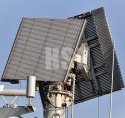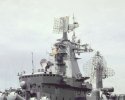Rotary sweep is the best for search and detection. If the beam continuously dwells on a single target, the single target is all it sees, and you won't be able to search and acquire new targets, and give you data about the overall environment. Even fixed faced radars do a rotary sweep using a fan shaped multi-lobe pattern.
With a rotary radar, the rate of rotation give you the rate which the track of the object is updated. So if the radar is turning at 60 rpms, then its updating targets at the rate of once per second. Radars and combat management systems also have track prediction algorithms to predict the target where its going, heading and speed while its not being updated. By the way, besides the point, do you know that online action games use track prediction on their servers? Its for a similar reason. Before the target is updated once again, there is lag and you minimize tracking errors with track prediction. Some rotary radars are back to back dual faced to increase the rate of updates by 2x.
There is no such thing as a rotary target illuminator. Target illuminators are fixed design solely meant to follow a target. Rotary radars are mainly search radars. Another separate radar, called fire control radars, are the ones that stick to the target.
Target illuminators are only needed for SARH or Semi Active Radar Homing missiles. These missiles don't have a radar emitter on their own. Just radar homing guidance system. Something is needed to light up the target so that missiles can home in on the target. The Standard SM-2 is a SARH missile so the Burke needs its SP-62 target illuminators. The HHQ-9 I am not sure if its SARH or ARH though I lean on the latter. ARH means the radio emitter is on the missile itself, so it can function autonomously in a fire and forget manner. If HHQ-9 is SARH, then the target illuminator is within the main panel of the Type 346 radar itself, the AESA nature of the radar allows it to use multiple beams simultaneously that can be digitally beam steered in different directions. If HHQ-9 is ARH, then there is no need for a target illuminator. An ARH missile still needs to be guided towards its long path to the target, so the ship radar still updates the missile track, and only when the missile is near the target, which is called the terminal stage or the "catch basket" the emitter on the missile lights up and the missile homes in. Because the radar emitter and receiving antenna on the missile is so small, the radar range for the missile seeker is limited, whic h is why for the journey up to near the end, it has to be command guided referred to as midphase updates. This is also true for SARH missiles.
If targets are much closer to the ship, ARH missiles are fired in a fire and forget manner, with the ship telling the missiles to tilt toward their targets so the missiles can activate their seekers. With SARH, the illuminators are already lighting up the targets as the missiles are launched, then tilted towards the targets. There is a difference how missiles are operated in short and long range. Similar principles are also with AAMs.
The Type 364 radar on top of the mast on the 052C/D, and also on the Type 054A in the rear mast, is mainly for searching the edge of the radar horizon for low flying or sea skimming threats. They cover a blind area the main Type 346 radars cannot.
Rotary radars don't divide themselves that is why there are multiple radars on a ship.
Range is determined by four factors --- frequency, power, transmit and receive gain of the antenna. Plus you must have a long pulse cycle or low PRF --- the pulse of the radar must be long enough for a long receive time to wait for the echoes to be received before it can transmit again. The longer the range, the longer is the receive time needed for the echo.
This ship is a good example of how things work.









